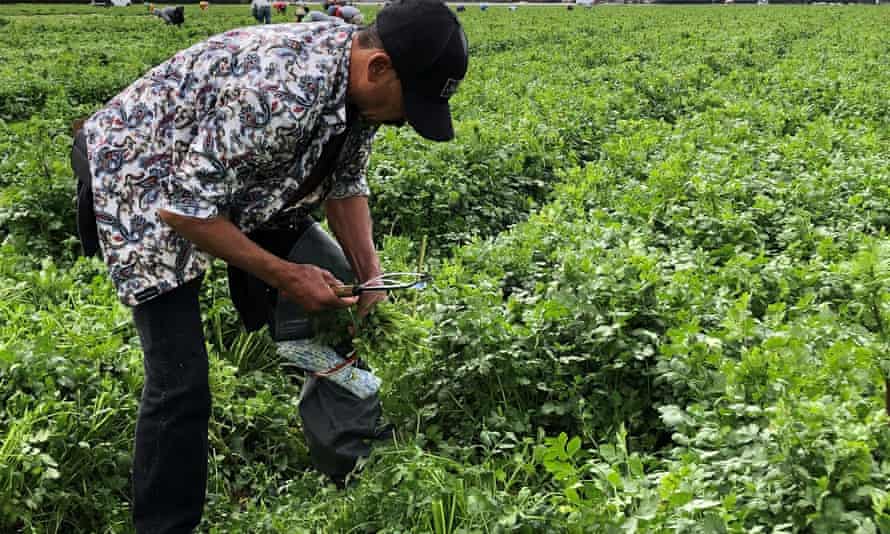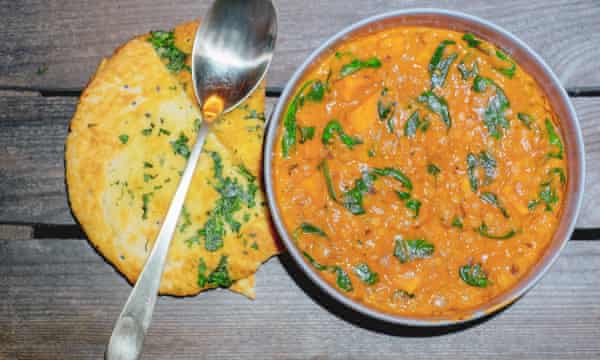‘It’s incredible’: how cilantro took over America | Food & drink industry
Just in time for the holidays, Chipotle has released its own cilantro soap. It is a joke, because cilantro tastes soapy to some people, but also it is real, in the sense that it costs $8 and is actually soap. “The perfect gift for cilantro lovers and haters alike,” the copy promises. It is a testament to the power of cilantro that it inspires this kind of passion. I am not saying it is fair. I am just saying: nobody is making gag gifts about marjoram.
In the US, “cilantro” generally refers to the stems and leaves, while the seeds are coriander; in most of the rest of the world the whole thing is just called coriander. And right now, cilantro is everywhere: in ceviche and on tacos, blended into chutneys and served alongside bowls of pho. It is in the produce aisle of your average big-box supermarket. It is in the “Southwest Chopped Salad Kit” at Target, and sprinkled on top of avocado toast. It is so ubiquitous as to be invisible; to comment on the rise of cilantro is like announcing that you’ve just noticed salt.
And yet very clearly there has been a change. Over the last two decades, the California cilantro crop has nearly doubled. In 1999, the state’s farmers grew 24,280 tons, according to the California Department of Agriculture’s numbers. In 2019 – the most recent stats available – it was up to 42,340. (2018 had technically been even better, at 61,471 tons, but crops are fickle. The point is, numbers are trending up.)

Frank Ratto is the president of Ratto Bros, which has been growing and shipping California produce since 1905. As a veteran of the cilantro business, he says that in the past 10 to 15 years demand for cilantro has shot up to become one of their top selling items, crucially outpacing basil, a height most herbs could never hope to reach. It is the number-one selling fresh herb at Kroger, a spokesperson told me. In the last two years alone, the company has seen double-digit growth.
“I remember when it was just in the small trays,” says Gustavo Arellano, the author of Taco USA: How Mexican Food Conquered America, and a Los Angeles Times columnist who has spent most of his life shopping in Mexican markets in southern California. “Now, there’s a fields’ worth of it. It’s incredible how much cilantro people go through.”
In the last year, the New York Times cooking pages, cultural arbiter that they are, published 105 cilantro-forward recipes, among them Yemeni zhug, Goan chicken cafreal and Moroccan saffron fish. Salt Bae, the internet sensation known for his steak theatrics, gave rise to Cilantro Papi, who could shred the herb in seconds. “Why are people putting cilantro in everything?” one cilantro hater asked Texas Monthly, miserably.
Many flavors hit a natural ceiling. Take rosemary, suggests Suzy Badaracco, president of the trend forecasting company Culinary Tides. Cilantro, though, does not have that problem; it is, despite its vocal detractors, on the whole, easy-going and well-liked. “If you had a party at your house, cilantro would show up in a sexy little dress, she would bring you a fabulous bottle of wine, and she would stay and help you clean up. Whereas watercress would show up drunk, probably throw up on the carpet and take your dog on the way out.” Cilantro is used in cuisines across the globe, and is adaptable to even more. “She can be the lead singer or the backup dancer, depending on what you put her in,” Badaracco says. “It’s kind of friendly with everything.”
It isn’t like there’s anything new about cilantro; if anything, the thing about cilantro is that it is very, very old. The plant comes up in early Sanskrit writings. It is mentioned in the bible. Seeds were found in King Tut’s tomb. It became a staple of Mexican cooking, South Asian and Southeast Asian cooking, Chinese and Middle Eastern cooking. Cilantro “is probably the most commonly used flavoring herb of any in the world” observed Tom Stobart in his 1982 aromatic opus, Herbs, Spices, and Flavorings, noting that it was now “catching on in the Western world”.
It’s so old that when I emailed Badaracco to get her read on the cilantro situation, she’d been confused about the question. “When you brought it up, I was like, ‘why on earth would she focus on cilantro,’” she told me later, on the phone. “Nobody’s talking about cilantro. It’s like focusing on parsley.”

But Americans, on the whole, have not been an especially herb-y people. We were slow on the uptake. Our herbs were minimal – you only really need six of them, Betty Crocker’s Picture Cook Book promised in 1950 – and most of them were dried. But in the late 70s – or perhaps the early 90s, depending on where in the country you were – that began to change.
The food writer Bee Wilson gives Italian basil the credit. “With its soft, heavily perfumed leaves,” she writes, rhapsodically, it was “the first herb to transform modern Western cooking.”. Fresh herbs fit the moment: processed food was out and the country was suddenly chef-obsessed.
“When my family first came here to America in 1975, we were so happy to see cilantro at the mainstream supermarket,” recalls chef and author Andrea Nguyen, whose family settled in San Clemente, California, after fleeing Vietnam. It is a backbone of Vietnamese cooking, and there it was, bunched in the produce aisle at Albertson’s. “We felt like, ‘oh, okay, we can be Vietnamese.’”

Nobody I talked to for this story could point to a single moment when it happened. “It’s not one thing,” says Gabriella Petrick, a food historian and Marie S Curie fellow at the University of Stavanger, in Norway. “It’s a bunch of things coalescing.” Between 1980 and 2000, the Hispanic population of the US more than doubled, and the number of Asian Americans more than tripled, and has, in the years since, tripled yet again.
“People who might have been using cilantro dishes before were transplanting and moving around the country to different regions and bringing dishes with them,” says Lori Flores, an associate professor of history at Stony Brook University who is at work on a book about the history of Latinx food workers in the north-eastern United states. “So it’s not just about external migration from other countries. It’s also the internal movements of people who are moving to the Pacific north-west or to the north-east or to the deep south.”
As Petrick puts it, “the expansion of communities who use lots of cilantro”, cooking at home, using enough cilantro that big-box chain grocers want in. And meanwhile, you also have a new burgeoning class of celebrity chefs – mostly white, generally middle-class – who are moving away from the Francophilic era of James Beard and Julia Child. “They’re the maverick generation, right? They don’t want the current continental cuisine anymore. They’re looking for the different flavors and combinations, and that’s what they bring back with them.”
Before she moved to Los Angeles and opened Border Grill with Susan Feiniger in 1985 – before she became one of Too Hot Tamales on the Food Network – Mary Sue Milliken was just a cilantro-deprived kid growing up in Michigan. “When I went to chef school in Chicago, even parsley was sort of still a little green garnish on a plate. You know, ‘have a sprig,’” she says.
When the pair opened their first restaurant, City Cafe, in 1981, they were using no cilantro. Then Feiniger went to study in India. “That upped our cilantro purchases – we went from zero to maybe three bunches a week.” A year after that, Milliken went to Thailand. “When I got back, we put some Thai dishes on the menu, and that upped it to maybe a bunch a day.” There was one curry in particular: red, topped with a heaping pile of cilantro. “Back then the Thai restaurants were, of course, doing that, but not restaurants run by white girls.” And then they opened the Mexican-inflected Border Grill. It would catapult them to stardom. It would also, by her estimate, at least triple their consumption of cilantro.
There may not be a single moment when American food culture changed forever, but if you had to pick one, you could do worse than 1991: the year US salsa sales overtook sales of ketchup. It was a sea change in the condiment industry, one so big there is a Seinfeld episode about it.
“It’s only in dollars,” Petrick says about the shift in popularity, salsa tending to be more expensive than Heinz. “It’s not in volume.” Still, it embodies a fundamental shift. “Salsa has become just ingrained in American culture as being American,” she argues. “The idea of salsa and chips just pervading American snack culture – that requires a lot of cilantro.”
From there, it is only a matter of time. “Generally, it takes about a generation – 20 or 30 years – for a new food to make it into your grocery basket on a weekly basis,” Petrick says. By the USDA’s numbers, we are right on schedule.
Not everyone feels positive about cilantro. There is a small but vocal minority of the population who do not experience the herb as a beguiling burst of freshness. What they taste is soap. There are lots of foods that some people like and other people don’t like – some people don’t like olives; I don’t personally care for passionfruit – but cilantro challenges the notion of a shared reality. “We fundamentally experience it differently,” explains John Hayes, a sensory and consumer scientist at Penn State University. The lovers and the haters are not tasting the same thing.
“The idea is, there’s a normal mutation in the normal population,” he explains; how you feel about cilantro is – at least, to some extent – a fluke of your genes. But to say that it’s just genetic is too simple. “People try to make taste and eating behavior all about nature versus nurture,” Hayes says, “but the answer is, it’s always both.” Genetic variability does “fundamentally alter” the way we perceive stuff; researchers at 23andMe got as far as pinpointing a specific gene that seemed to correlate with distaste for the herb. But they also found that genetics seemed to be a tiny piece of a larger puzzle. “With repeated exposure and other rewards, you can learn to like things,” Hayes tells me. Even, probably, cilantro.
After all, people develop tastes for all kinds of once-repellent flavors. “We know people do it in the case of beer, and we know people do it in the case of coffee, and we know people do it in the case of chili peppers,” he points out. There is no particular reason cilantro should be different. “It should be easy to study, conceptually,” says Hayes, but good studies are expensive, and “it’s really hard to convince the National Institutes of Health to give somebody $2m to spend five years figuring out why some people do or don’t like salsa.”
“I definitely feel like it’s very unique,” says Milliken, who is nibbling on cilantro in her Los Angeles garden and reporting back by phone. “It’s very … fresh tasting,” she considers. “Green. It calls out for lime and chili. It’s really dancing in your mouth.”
Source: theguardian.com

